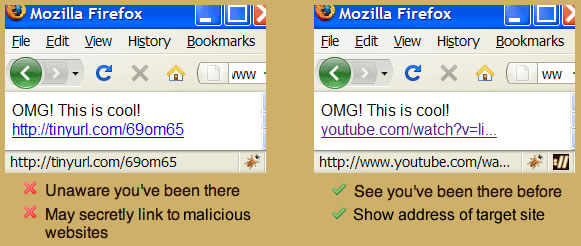Today's ubiquitous URL shorteners have seen a dramatic increase in popularity the last couple of years - much of it driven by the rise in popularity of Twitter itself. They are great for keeping character count at a minimum or to make sharing easier. Some even bring a few unique features to the table, like enabling statistics or the ability to select your own keyword, but as convenient as shorteners are they also introduce some new issues.
There's significant variance from one service to another when it comes to uptime, for example, while on the other hand given that the process involves using an HTTP redirect there's also the latency issue. But perhaps more importantly is the fact that they obscure the target address and thus may be used to trick users to an unexpected destination.
This means users are susceptible to something as innocent as being rickrolled to potentially much more harmful exposure, like being redirected to scamming websites or malware-ridden pages. Fortunately, there are several ways to peek behind a shortened URL to see exactly where the link will take you before clicking it, so let's take a quick look at a few of them.
All major URL shortening services offer an option to preview what's behind their links, so you can know exactly what you are visiting and thus avoid surprises. Shortening services bit.ly and Google's own goo.gl, for example, will show you additional stuff like total clicks, a QR code, shares on social networking sites and the fully expanded URL, simply by appending a plus sign at the end of the shortened address (https://bit.ly/gULvsR+).

Is.gd does the same thing by adding a hyphen at the end of the URL (https://is.gd/jatQq-), while on TinyURL you can see where the link leads by prefixing the word "preview" to the front of the URL (https://preview.tinyurl.com/32jre2o). These are the most commonly used services but a more comprehensive list can be found here.
Unfortunately not all services offer the ability to preview the original address before visiting it. If someone else sends you a shortened link from one of these sites and you want to preview it, you may still be able to do so using a third-party service. ExpandMyURL.com and LongURL offer this functionality.
The above options are fine for checking the occasional link but when you're dealing with shortened URLs on a regular basis it's better to automate this process rather than editing links manually or copying them to another website. Firefox users can save a lot of time through a simple extension.
Bit.ly offers its own service-specific add-on but if you want to cover the full spectrum of URL shorteners get the one provided by Long URL Please.

Google Chrome also has two extensions available that expand shortened URLs (as suggested by readers - thanks!). Or in case Opera is your favorite poison, look here.
Links will be automatically replaced with their original address but keeping the same number of characters.
Users of other browsers can get the same functionality by installing the Long URL Please or Expand My Url bookmarklet.
Simply drag one of the previous links to your bookmarks bar and clicking them will replace any short links in the active page with their original address while keeping the same number of characters.